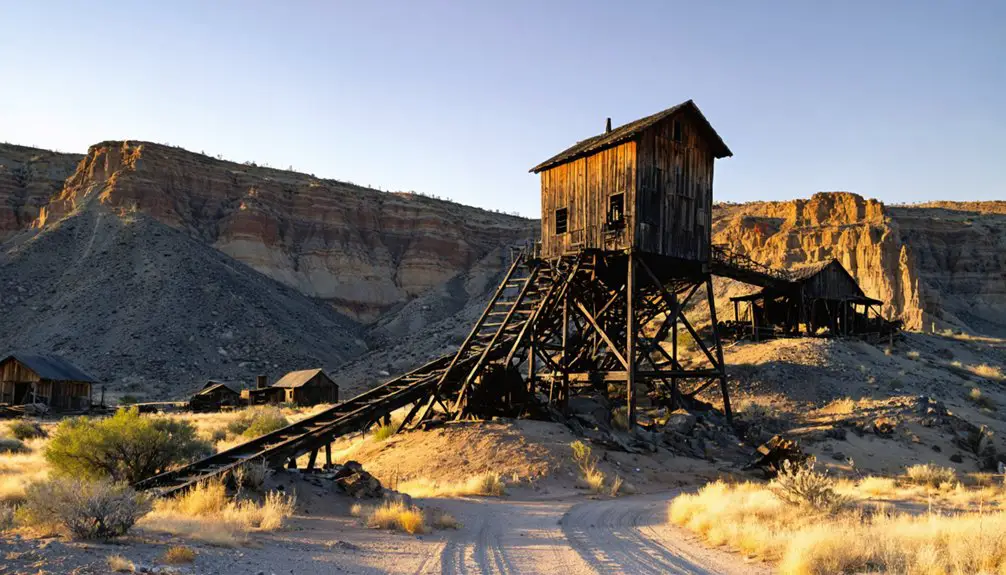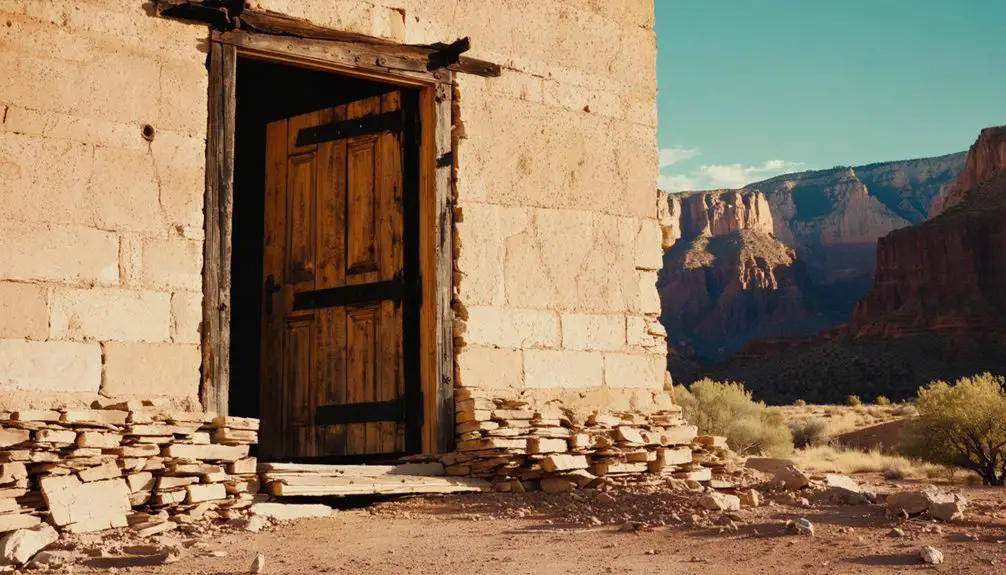You’ll discover fascinating ghost towns throughout Utah’s Uintah County, where gilsonite mining towns like Dragon and Rainbow once flourished along the historic Uintah Railway. These abandoned settlements emerged after the 1868 discovery of gilsonite, thriving between the 1910s and 1930s before declining post-World War II. Today, weathered structures and mining remnants tell stories of hardy pioneers, challenging railway operations, and bustling communities. The rich history of these forgotten towns holds countless untold tales.
Key Takeaways
- Dragon was a prominent gilsonite mining town that flourished between 1910-1930s before becoming abandoned after World War II.
- The Uintah Railway connected mining settlements through 63 miles of track, serving communities like Dragon, Rainbow, and Watson until 1938.
- Mining towns faced harsh living conditions with basic wooden structures, shared outhouses, and limited access to essential resources.
- The Gilson Asphaltum Company’s control of gilsonite resources significantly influenced the development and decline of these mining settlements.
- Local preservation groups work to protect ghost town structures while supporting heritage tourism and paranormal interest activities.
The Rise and Fall of Dragon: A Gilsonite Mining Legacy
While gilsonite’s discovery in Utah’s Uintah Basin dates back to 1868, the town of Dragon emerged as an essential mining center after 1903 when the Uintah Railway connected this remote outpost to broader markets.
The ore was initially extracted using simple hand tools and transported by wagon before more advanced mining methods were developed.
You’ll find Dragon’s story intertwined with early mining techniques, from picks and shovels to horse-powered hoists, as miners battled the challenging but profitable gilsonite veins.
Dragon’s prosperity peaked during the 1910s-1930s, but economic shifts would ultimately seal its fate.
Despite Dragon’s golden age in the early 20th century, shifting economic tides would eventually bring the mining town’s downfall.
The Gilson Asphaltum Company, which later became American Gilsonite Company, controlled most of the region’s gilsonite resources by 1903.
The Great Depression, combined with depleting ore veins and the shift toward truck transportation, gradually diminished the town’s importance.
When mining operations moved north to Bonanza and the railway ceased operations after World War II, Dragon’s destiny as a ghost town was sealed, though its legacy lives on in Uintah County’s rich mining history.
Uintah County’s Mining Heritage and Settlement Patterns
The story of Uintah County’s mining settlements reaches far beyond Dragon’s gilsonite boom, shaping the region’s early development through complex interactions between miners, ranchers, and Native American communities.
You’ll find that historical governance played a pivotal role when the federal government withdrew 7,000 acres from the Uintah Reservation for gilsonite extraction, creating “The Strip” – an area that initially struggled with lawlessness. French trapper Antoine Robidoux established an early trading presence in the region, setting up a post that facilitated commerce between settlers and indigenous peoples.
While mining techniques evolved to extract various minerals, including uranium, silver, and gold, the region’s development wasn’t solely about mineral wealth. The area’s economic stability was bolstered by cattle and hay production.
Early settlers established irrigation networks that birthed towns like Jensen and Maeser. The Uintah Railway connected these communities, transforming isolated mining camps into thriving settlements with stores, schools, and churches – though many would later become ghost towns as ore deposits depleted.
Life Along the Uintah Railway: Transportation and Commerce
You’ll find the Uintah Railway‘s narrow-gauge tracks winding through some of Utah’s most challenging terrain, where specialized Mallet locomotives conquered the steep grades of Baxter Pass to connect remote mining settlements with larger markets.
Along this crucial 63-mile lifeline between Mack, Colorado and Watson, Utah, the railway’s unique cargo of flammable Gilsonite required careful handling in burlap sacks on open flatcars, while also transporting essential supplies like mail, groceries, and livestock to sustain the growing communities. The railway’s treacherous route included crossing thirty-six bridges between Mack and Atchee.
The stops along the route, including Dragon, Rainbow, and Carbonera, became bustling hubs where you’d witness the daily rhythm of commerce as trains delivered everything from wool to lumber, supporting the economic backbone of these now-vanished towns. After decades of service, competition from the trucking industry ultimately led to the railway’s closure in 1939.
Railway Construction and Routes
Stretching across challenging terrain, the Uintah Railway‘s initial 53-mile narrow gauge track connected Mack, Colorado to Dragon, Utah in 1905, establishing an essential transportation link for the region’s burgeoning Gilsonite industry.
If you’re fascinated by railway engineering, you’ll marvel at how the line conquered Baxter Pass at 8,437 feet, featuring grades up to 7.5% and 73 bridges. Early operations relied on Shay locomotives until more powerful equipment arrived.
For ghost town exploration enthusiasts, the railway’s path through Atchee, a now-vanished settlement named after a Ute chief, offers glimpses into the past. The railway’s revolutionary articulated locomotives #50 and #51 dramatically improved the efficiency of Gilsonite transport over these challenging routes.
The line’s 1911 extension added 13.5 miles to Watson and Rainbow, though plans for further expansion to Vernal and Bonanza never materialized.
You’ll find no level track except near Mack, as the railway carved through deep arroyos prone to flash floods.
Supply Chain Operations
While modern railway operations focus on waxy crude oil transport, historic supply chain operations along the Uintah Railway served as an essential lifeline for the region’s commerce and communities.
The new Savage transload facility near Wellington represents the latest evolution in regional transportation infrastructure. You’d have witnessed a stark contrast to today’s sophisticated transloading efficiency, where heated storage tanks and insulated railcars maintain crude oil at precise temperatures. Back then, supply chain logistics centered on moving vital goods, minerals, and agricultural products that sustained the area’s remote settlements. The unique challenges of transporting waxy crude oil that solidifies at 100 degrees Fahrenheit have shaped modern infrastructure development.
Today’s Wellington terminal, with its 277-acre industrial footprint and dual heated storage system, reflects how far we’ve come.
You’ll find it’s designed to handle up to 350,000 barrels daily, replacing the simpler operations of the past when trains carried basic provisions to isolated towns that have since become ghost towns.
Community Life Between Stops
Between 1905 and 1938, the Uintah Railway served as more than just a transportation system – it became the social backbone of remote Utah communities, weaving together the daily fabric of life through its passenger and freight services.
You’d find the rail travel experience uniquely communal, with passenger cars doubling as gathering spaces where locals shared meals and news. The combined baggage, mail, and coach services created natural community gatherings at station stops, while the 63-mile journey offered spectacular views that fostered regional pride.
Before automobiles became common, these trains connected you to essential services, regional markets, and social opportunities. Whether you were a miner shipping Gilsonite, a rancher moving livestock, or a family receiving mail and supplies, the railway’s regular service rhythm defined daily life in these now-vanished communities.
Ghost Towns and Paranormal Activity: A Cultural Phenomenon

Throughout Uintah County’s abandoned settlements, tales of paranormal activity have become deeply woven into the cultural fabric of these ghost towns.
You’ll find stories passed down through generations, telling of spirits tied to mining accidents, sudden abandonments, and frontier hardships. These cultural legends have sparked a growing paranormal tourism industry, where you can join guided ghost tours and paranormal investigations that capture unexplained phenomena like EMF spikes, mysterious sounds, and apparitions.
Unlike more commercialized haunted locations across America, Uintah County’s ghost towns offer a raw, authentic connection to the region’s mining and pioneer past.
You’ll experience atmospheric encounters that reflect the area’s unique westward expansion narrative, while contributing to the preservation of these historic sites and their compelling stories.
Exploring Abandoned Mining Camps of the Uinta Basin
If you’d traveled through the Uinta Basin’s mining camps in their heyday, you’d have found challenging living conditions where miners and their families endured harsh weather, isolation, and basic amenities in company-built housing clustered around the mines.
The Uintah Railway served as the region’s lifeline, connecting these remote camps to the outside world while transporting valuable Gilsonite to market from 1904 to 1939.
Your journey through Dragon, Rainbow, or Watson would’ve revealed these towns’ determined spirit through their churches, schools, and stores that created genuine communities despite their temporary nature.
Mining Camp Living Conditions
Life in Uintah County’s mining camps presented harsh realities for the workers and families who called these remote settlements home.
You’d find yourself living in hastily built wooden structures that offered little protection against Utah’s brutal winters. The mining camp infrastructure was basic at best, with residents sharing primitive outhouses and relying on unreliable water sources from streams or wells.
Communal living challenges defined daily existence, as many miners packed into crowded boarding houses and bunkhouses.
You’d face constant struggles with limited access to food, supplies, and medical care. The camps’ isolation meant you’d depend on irregular deliveries by rail or stagecoach for necessities.
Fire hazards loomed large, with wooden buildings illuminated by open flames and no formal firefighting services available.
Railway Transport Impact
When the Uintah Railway began operations in the late 1800s, you’d find it revolutionizing transportation across Utah’s remote Uinta Basin.
These railway innovations transformed gilsonite mining from a limited venture into a thriving industry, connecting isolated camps like Dragon and Rainbow to essential markets.
You’ll discover how these economic transformations rippled through the region, as mining camps evolved into bustling communities with schools, hotels, and stores.
The railway slashed transportation costs and travel times, making previously unprofitable mining operations viable.
But by the late 1930s, you’d witness a dramatic shift as trucks began replacing trains.
The railway’s closure in 1939 led to the rapid decline of these once-vibrant communities, and by 1940, places like Dragon had dwindled to just 10 residents.
The Role of Gilsonite in Shaping Uintah’s Ghost Towns

Deep beneath the rugged terrain of Uintah County, the discovery of gilsonite veins sparked a remarkable transformation that would give rise to numerous mining settlements, many of which would eventually become ghost towns.
You’ll find the stories of towns like Dragon, Rainbow, Watson, and Bonanza woven into the fabric of gilsonite mining history. These once-bustling communities flourished with stores, boarding houses, and schools, offering workers and their families a chance at prosperity.
As economic fluctuations and resource depletion took their toll, these settlements faced inevitable decline. The Gilson Asphaltum Company’s dominance over local resources shaped the destiny of these towns, while the shift from railroad transport to vehicular shipping in the late 1930s further altered their fate.
Today, these silent remnants stand as evidence to the boom-and-bust cycle that defined Utah’s mining era.
Historical Preservation and Tourism in Uintah’s Ghost Towns
Throughout Uintah County’s remote landscapes, dedicated preservation groups like the Utah Ghost Town Project (UGTP) and Utah Ghost Town Association work tirelessly to protect the region’s abandoned settlements.
You’ll find their efforts focus on maintaining structural integrity while balancing public access with site protection, though preservation challenges include limited infrastructure and remote locations.
Tourism strategies now blend historical education with paranormal intrigue, especially around hotspots like Skinwalker Ranch.
You can join organized ATV tours, attend events like PhenomeCon, or explore well-preserved ruins through guided experiences.
The region’s ghost towns have gained national attention through TV shows and documentaries, attracting visitors interested in both historical and supernatural elements.
Local initiatives guarantee these activities respect Indigenous lands and cultural heritage while supporting the area’s growing heritage tourism economy.
The Impact of Geography on Settlement Abandonment

The unique geography of Uintah County played a decisive role in both the rise and fall of its ghost towns, with settlements like Dragon and Watson emerging in locations dictated by mineral deposits but ultimately succumbing to their isolation.
Geography determined the birth and death of Uintah County’s ghost towns, as mineral riches drew settlers to remote places they couldn’t sustain.
When you explore these abandoned settlements today, you’ll understand how geographic barriers created insurmountable challenges to economic sustainability.
Here’s what shaped their fate:
- Remote locations near Utah’s eastern border limited access routes and trade opportunities.
- Rugged terrain with canyons and plateaus complicated transportation beyond single rail lines.
- Harsh desert climate with limited rainfall made agriculture nearly impossible.
- Dependence on specific mineral deposits left towns vulnerable when resources were depleted or became unprofitable.
These geographic constraints, combined with the region’s isolation, ultimately sealed the fate of these once-bustling mining communities.
Frequently Asked Questions
Are There Any Dangerous Wildlife Encounters When Visiting Uintah County Ghost Towns?
You’ll need wildlife safety awareness for black bears, mountain lions, rattlesnakes, coyotes, and venomous insects. Take encounter precautions by traveling in groups and storing food properly to minimize risks.
What Survival Supplies Should Visitors Bring When Exploring These Remote Locations?
Pack survival kits with navigation tools, water, first-aid supplies, emergency shelter, and essential gear like flashlights. You’ll need food, sun protection, warm clothing, and communication devices for safety.
Can Visitors Legally Collect Artifacts From Uintah County Ghost Towns?
You can’t legally collect artifacts without permits due to strict preservation laws and regulations. Instead, photograph what you find and report significant discoveries to local authorities for proper documentation.
Which Ghost Towns Are Accessible by Standard Vehicles Versus Requiring Off-Road Transportation?
You’ll find Dragon, Buner Hollow, Whiterocks, Randlett, and Fort Duchesne accessible by regular cars, while you’ll need off-road vehicles to explore Dragon Canyon, Gilsonite camps, and backcountry mining remnants.
Do Any Descendants of Original Ghost Town Residents Still Live Nearby?
You’ll find many descendants maintaining family ties near Vernal and Ashley Valley, where they preserve local legends from their ghost town ancestors through historical societies and community gatherings.
References
- https://film.utah.gov/spooky-rural/
- https://hub.arcgis.com/maps/utah::ghost-towns-in-utah
- https://jacobbarlow.com/2020/03/03/ghost-towns-in-utah/
- https://www.visitutah.com/articles/unknown-otherworldly-near-vernal
- https://en.wikipedia.org/wiki/Dragon
- https://archiveswest.orbiscascade.org/ark:/80444/xv620726
- https://gilsoniteco.com/2017/04/09/gilsonite-history/
- https://gilsoniteco.com/gilsonite-utah-mine/
- https://geology.utah.gov/map-pub/survey-notes/utah-still-supplying-gilsonite-to-the-world-after-125-years/
- https://geology.utah.gov/map-pub/survey-notes/gilsonite-an-unusual-utah-resource/



